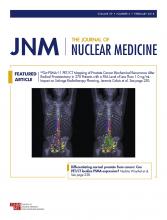TO THE EDITOR: We read with great interest a recent publication by Lohrke et al. describing their preliminary data related to the detection of clots using 18F-glycoprotein 1 (18F-GP1) as a PET tracer with high sensitivity for this purpose (1). The preliminary in vitro experiments demonstrated that 18F-GP1 binds specifically with high affinity to the GPIIb/IIIa receptor, which is involved in platelet aggregation. In addition, these investigators generated successful results from cynomolgus monkey studies. The latter was accomplished by introducing catheters into the ascending aorta, carotid arteries, and vena cava. The authors correctly point out that previous attempts with radiotracer-based imaging to detect clots either in the venous or the arterial systems have had limited success for various reasons and that some have therefore been abandoned for this purpose. Overall, the presented results are interesting and merit further investigation, but we do have some comments and caveats.
Recently, we wrote 2 editorials describing the limitations of PET imaging in certain settings because of the physical and biologic shortcomings that are associated with the applications of this modality (2,3). We have described several research initiatives that have not reached their intended aims despite promising results in animals and in vitro experiments. These limitations are also applicable to the detection of clots with PET radiotracers and should therefore be taken into consideration in future attempts to detect clots. Soon after the thrombosis occurs in an artery, it will be nearly impossible for radiolabeled tracers to reach the clot and allow its visualization by noninvasive imaging techniques. This is the case when clots are formed in critical arteries such as coronaries and tributaries of internal carotid arteries and when clots are formed in the pulmonary arteries after embolism from the peripheral veins. Investigators should be aware of this fact and be cautious when investing in research activities aimed at detecting clots in the arteries.
Furthermore, the overall mass of platelets that are incorporated into the thrombi may not provide the required volume and binding surface to be detected with in vivo PET if the agent clears rapidly from the circulation. Such agents may not prove to be suitable candidates for visualizing venous clots. Also, as we have pointed out in our recent editorials, the spatial resolution of PET imaging in human applications is approximately 8–10 mm. As such, detection of small clots with PET may face serious challenges and not succeed in the future. The partial-volume effect, combined with rapid clearance of 18F-GP1, may result in negative results, particularly with small clots. Thus, demonstrating the efficacy of the approach proposed by Lohrke et al. in practical and relevant clinical settings is crucial if the probability of success with such compounds is to remain high. In fact, similar attempts in the past with 99mTc-apcitide have shown suboptimal results (4).
However, it is feasible to detect clots in the venous system that only partially occlude the lumen of the affected vessel, as administered radiotracers can reach and label the targeted cells (platelets or white cells) or other biologic sites (fibrin). This labeling can result in visualization of the venous clots with relatively high success. Attempts to visualize clots with antifibrin antibodies were successful based on past experience (5,6). Similarly, targeting activated inflammatory cells such as white cells that are incorporated into the clot results in detection of venous thrombi by 18F-FDG PET imaging. In fact, preliminary published data indicate that the sensitivity of 18F-FDG in detecting venous clots is nearly 100% (7–9). 18F-FDG and radiolabeled antibodies remain in the circulation for an extended period, allowing significant accumulation of the tracer at the thrombotic sites over time.
We would like to draw attention to 18F-FDG results previously presented by our group and others, as they are similar to those presented by Lohrke et al. Several of the (very relevant) questions and caveats put forth by Lohrke et al. in their introduction are already assessable by 18F-FDG, and some of the limitations of 18F-FDG are likely also true for 18F-GP1. First, only very acute venous (and arterial) nonoccluding thrombi were assessable with 18F-GP1 in the setup presented, but it remains unknown how the uptake is in older, chronic thrombi. This question has already been successfully evaluated using 18F-FDG, with clear signs of declining 18F-FDG avidity over time (10,11). Also, the catheter-based method favors thrombus formation in the venous bed and major arteries, but there is no evidence of any 18F-GP1 uptake related to pulmonary embolism—a major drawback of 18F-FDG (9,12). Finally, it is perceivable that 18F-GP1 better discriminates conventional bland thrombi from etiologies such as septic emboli, but this discrimination still requires prior imaging with sufficient sensitivity to detect the thrombus in the first place, and 18F-FDG has demonstrated high sensitivity for several etiologies, including conventional bland thrombi, septic emboli, and tumor thrombosis (8,9,13).
We believe the future management of patients with thrombotic disorders will heavily depend on the detection and characterization of clots in the venous system, and despite the interesting preliminary results presented by Lohrke et al., 18F-FDG PET currently has the greatest potential for this purpose. If validated by well-designed prospective clinical trials, 18F-FDG PET imaging has great potential for replacing or at least complementing other diagnostic modalities for accurate diagnosis of thromboembolic disorders.
Footnotes
Published online Sep. 14, 2017.
- © 2018 by the Society of Nuclear Medicine and Molecular Imaging.







